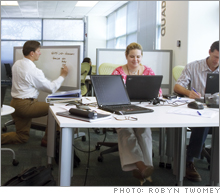Designing the 21st century cubicleFrom conference rooms that collapse to desks that roll, companies like Google and Cisco are giving their offices a makeover to meet the needs of a mobile workforce.(Business 2.0 Magazine) -- The configuration of an office can have a dramatic impact on how employees do their jobs. No secret there. Yet since the late 1960s, corporate workplaces have been dominated by cubicles and private offices - an arrangement that does little to encourage interaction and communication.
Some have tried eliminating private workspaces altogether, but a few early experiments, like ad agency TBWA/Chiat/Day's infamous mid-1990s "virtual office" in Manhattan, flopped, leading only to turf wars and employee strife. Nevertheless, after sifting through the ruins of such high-profile disasters, smart companies like Cisco Systems (Charts) and Google (Charts) are rethinking the fundamentals of office design, led by the realization that collaboration is an increasingly critical ingredient for business success. "There are few organizations that don't rely on some kind of collaboration today," says Franklin Becker, director of the international workplace studies program at Cornell University. "But to make that work, you have to create a motive for people to get out of their individual space." Plenty of space to meet and eat One-size-fits-all approaches seldom work. Software engineers need more privacy than salespeople, for example, yet they also need more encouragement to mix and mingle. Consider Google. The Mountain View, Calif. giant needed to foster employee interaction while giving software engineers the privacy they need to crank out code. As a result, Google workers are assigned desks and offices that are arrayed around "Main Street" - an airy central atrium that employees traverse several times each day. Popular amenities like kitchenettes stocked with snacks are never more than 100 feet away from any desk, while pool tables provide an excuse to linger and talk. Collapsible conference rooms are scattered throughout the office, so workers can always find a private place to huddle on specific problems. Meanwhile, a central staircase made of Brazilian hardwood and with electrical outlets built into the steps doubles as an informal meeting place. To turn a familiar maxim on its head, when it comes to office design, function often follows form. That is, when an office is configured to maximize employee interaction, collaboration becomes an integral part of every workday. _____________________ Bottom Line Design Awards 2006 Stuck in a cubicle? Try this chic decor |
| |||||||||||||||||

